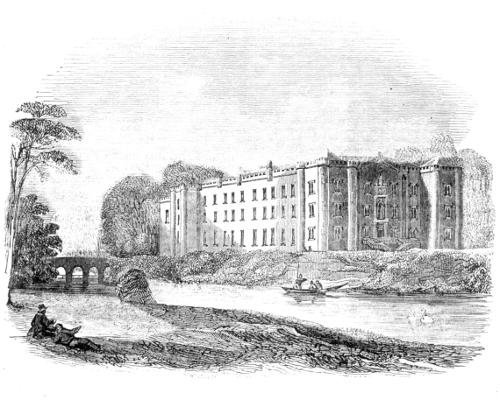THE IRISH PENNY JOURNAL.
| Number 42. | SATURDAY, APRIL 17, 1841. | Volume I. |

ANTRIM CASTLE, THE RESIDENCE OF THE EARL OF MASSARENE
The fine old mansion of the noble family of Skeffington, ofwhich our prefixed wood-cut will give a very correct generalidea, is well deserving of notice, not only from its grandeur ofsize and the beauty of its situation, but still more as presentingan almost unique example, in Ireland, of the style of domesticarchitecture introduced into the British islands fromFrance, immediately after the Restoration.
This castle is generally supposed to have been erected inor about the year 1662, by Sir John Clotworthy, Lord Massarene,who died in 1665, and whose only daughter and heir,Mary, by her marriage with Sir John, the fifth baronet ofthe Skeffington family, carried the Massarene estate and titleinto the latter family. But though there can be no doubt,from the architectural style of the building, that Antrim castlewas re-edified at this period, there is every reason to believethat it was founded long before, and that it still preserves, toa great extent, the form and walls of the original structure.The Castle of Antrim, or Massarene, as it is now generallycalled, appears to have been originally erected early in thereign of James I., by Sir Hugh Clotworthy, who, by the establishmentof King James I. had the charge of certain boatsat Massarene and Lough Sidney, or Lough Neagh, with anentertainment of five shillings Irish by the day, and 18 men toserve in and about the said boats, at ten-pence Irish by theday each. This grant was made to him by patent for life, in1609; and on a surrender of it to the king in 1618, it wasre-granted to him, and his son and heir John Clotworthy,with a pension of six shillings and eight pence per day, and tothe longer liver of them for life, payable out of the revenue.For this payment Sir Hugh Clotworthy and his son were tobuild and keep in repair such and so many barks and boatsas were then kept upon the lough, and under his command,without any charge to the crown, to be at all times in readinessfor his Majesty’s use, as the necessity of his serviceshould require. John Clotworthy succeeded his father ascaptain of the barks and boats, by commission dated the28th January 1641, at 15s. a-day for himself; his lieutenant,4s.; the master, 4s.; master’s mate, 2s.; a master gunner,1s. 6d.; two gunners, 12d.; and forty men at 8d. each.
On the breaking out of the rebellion shortly afterwards, thegarrison at Antrim was considerably increased, and the fortificationsof the castle and town were greatly strengthened[Pg 330]by Sir John Clotworthy, who became one of the most distinguishedleaders of the parliamentary forces in the unhappyconflict which followed. Still commanding the boats of LoughNeagh, that magnificent little inland sea, as we may not veryimproperly call it, became the scene of many a hard contestbetween the contending parties, of one of which Sir R. Coxgives the following graphic account. It took place in 1642.
“But the reader will not think it tedious to have a descriptionof a naval battel in Ireland, which happened in this manner:Sir John Clotworthy’s regiment built a fort at Toom, andthereby got a convenience to pass the Ban at pleasure, andto make incursions as often as he pleased into the county ofLondonderry. To revenge this, the Irish